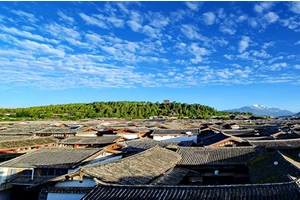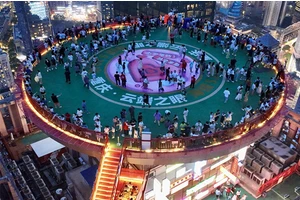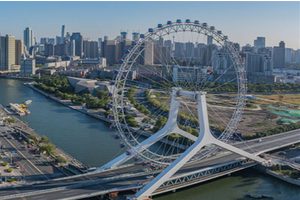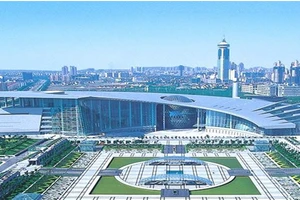Ezhou tourism administration
Ezhou Tourism Bureau has the following four main internal organs according to its responsibilities:
1. Office: responsible for external liaison, coordination and reception, handling comprehensive documents and messages, arranging daily meetings and supervising various matters, coordinating government affairs of various departments, managing confidential, confidential, archives, printing, information, suggestions and proposals, managing real estate, vehicles and office automation, and managing by objectives, social security and finance.
2. Development Planning Department: responsible for implementing tourism laws and regulations, formulating the city's tourism development strategies and policies, studying reform proposals, formulating and implementing development plans, coordinating the development and protection of tourism resources, guiding the planning of key tourist areas, managing the industry and evaluating the quality of tourist areas, including tourist toilets and farmhouses, and taking charge of project establishment and guiding specific tourism projects.
3. Development and Promotion Section: leading the city's tourism market development strategy, formulating annual promotion plans, being responsible for tourism image publicity, organizing product market development and promotion activities, guiding tourism and entertainment work, participating in large-scale event organization and foreign exchange, and being responsible for planning tourism investment projects and formulating tourism product development policies.
4. Quality Management Section: responsible for the implementation of tourism industry standards and the study of local standards, managing travel agencies, supervising tourism service standards, guiding star rating and market order, supervising travel insurance, participating in the handling of safety accidents, managing excellent tourist cities and building spiritual civilization, managing special tourism affairs, guiding education, training and qualification certification, managing tour guides and travel agency leaders, supervising the law enforcement work of tourism quality supervision offices and supervision brigades, coordinating the quality guarantee of travel agencies and guiding trade associations.
In addition, there are discipline inspection and supervision institutions established in accordance with regulations.
Extended data
According to the spirit of the Notice of the General Office of Hubei Provincial Committee of the Communist Party of China and the General Office of Hubei Provincial Government on Printing and Distributing the Institutional Reform Plan of Ezhou Municipal People's Government (E Ban Wen [2009] No.96) and the Notice of Ezhou Municipal Committee of the Communist Party of China and Ezhou Municipal People's Government on Printing and Distributing the Implementation Opinions on the Institutional Reform of Ezhou Municipal People's Government (E Zhou Wen [2010] No.9), Ezhou Tourism Bureau was established as the working department of the municipal government.
Ezhou City, Hubei Province
Ezhou Lianhua Mountain
Ezhou Lianhua Mountain
Ezhou Lianhua Mountain
Ezhou has jurisdiction over three county-level administrative regions, namely Echeng, Huarong and liangzi lake, two development zones, namely gedian and Ezhou, and three sub-district offices, namely Fenghuang, Gu Lou and Xishan. The city has an area of 1,596 square kilometers and a total population of 1,097,900 (registered population).
In 2013, Ezhou achieved a GDP of 63.094 billion yuan, an increase of 10.5% over the previous year at comparable prices. Among them, the primary industry reached 7.851 billion yuan, an increase of 4.9% over the previous year; The secondary industry reached 37.508 billion yuan, an increase of 12.2% over the previous year; The tertiary industry reached 17.735 billion yuan, an increase of 9% over the previous year. The ratio of tertiary industrial structure was adjusted from 12.3:60.1:27.6 in 2012 to 12.4:59.4:28.1. According to the resident population, the city's per capita GDP reached 59,791 yuan, a net increase of 6,535 yuan or 12.3% over the previous year. In 2013, the total number of employees in the whole society reached 648,500, an increase of 1.22% over the previous year, of which 207,800 were engaged in the primary industry, 208,500 in the secondary industry and 232,200 in the tertiary industry. The annual investment in fixed assets was 56.719 billion yuan, an increase of 28.1% over the previous year; The added value of industries above designated size reached 36.1 billion yuan, an increase of 13.2% over the previous year; The budget revenue of local public finance was 3.843 billion yuan, a year-on-year increase of 16.4%; The total retail sales of consumer goods in the whole society was 20.51 billion yuan, an increase of 13.1% over the previous year; The actual utilization of foreign capital was US$ 162 million, an increase of 16.3% over the previous year; Foreign trade exports reached US$ 176 million, a year-on-year increase of 12%; The per capita disposable income of urban residents was 20,878.16 yuan, an increase of 8.14% over the previous year.The per capita net income of rural residents was 10,209.72 yuan, an increase of 12.54% over the previous year. In 2013, the city's consumer prices rose by 2.7%, down 0.2 percentage points from the previous year, of which food prices rose by 5%. The retail price of commodities increased by 1.9%, the ex-factory price of industrial producers decreased by 0.6%, and the purchase price of industrial producers decreased by 2.4%. The city's main economic indicators have achieved the expected goals, and the growth rate is faster than the provincial average.
In 2001, the city's total agricultural output value reached 13.85 billion yuan, an increase of 7.4% over the previous year. Among them, the output value of planting industry was 3.98 billion yuan, an increase of 4.6% over the previous year; The output value of animal husbandry was 3.42 billion yuan, an increase of 4.4% over the previous year; The fishery output value was 6.2 billion yuan, an increase of 13.4% over the previous year. The added value of agriculture in the city reached 7.16 billion yuan, up 12.1% year-on-year. The annual grain output reached 355,100 tons, an increase of 2.94% over the previous year, achieving "ten consecutive increases"; Cotton output was 7,000 tons, down 5.75% from the previous year; Oil production was 60,800 tons, up 2.1% over the previous year; The vegetable output was 969,900 tons, an increase of 2.4% over the previous year; The output of aquatic products was 428,000 tons, an increase of 7.94% over the previous year; 1.2 million pigs were slaughtered, an increase of 5.94% over the previous year; 15.5943 million poultry were released, an increase of 5.5% over the previous year. In the whole year, 56 eco-agricultural demonstration bases were built, and 9 geographical indication trademarks were registered. The first organic agricultural product testing and certification center in China was settled in Ezhou. The new community in Changshan was listed as the national modern eco-agricultural innovation demonstration base, and Ezhou was named the Wuchang fish standardized breeding demonstration city and the national "food safety project" demonstration city. Agricultural industrialization has been promoted rapidly, with 4 provincial leading enterprises, 113 farmers' professional cooperatives and 210 family farms added throughout the year. The output value of agricultural and sideline products processing reached 21.03 billion yuan, a year-on-year increase of 31%; The ratio of the output value of agricultural and sideline products processing industry to the total agricultural output value increased from 1.27% in the previous year to 1.39%.
In 2013, Ezhou launched the "Key Industry Multiplication Plan", introduced a series of measures to promote the steady growth of industrial economy and support the development of market players, raised 1.02 billion yuan of financial intermittent funds, instigated funds from all parties to inject into the real economy, and accelerated the pace of economic transformation and upgrading. The effect of structural adjustment gradually emerged, and the economic development situation gradually improved. The city's industrial electricity consumption began to grow positively in August, reversing the negative growth for 20 consecutive months, and key industries and key enterprises began to get out of the trough. New building materials, high-end equipment manufacturing, biomedicine and other emerging industries have developed steadily. The production industry represented by e-commerce has developed rapidly. The construction of an 18-square-kilometer e-commerce base has been smooth, and well-known e-commerce enterprises at home and abroad such as Amazon, Prologis, Vipshop, Dangdang and Suning.cn have been successfully introduced. gedian Development Zone has been approved as the first batch of e-commerce demonstration bases in the province. By the end of the year, there were 487 large-scale industrial enterprises in the city, a net increase of 45 over the previous year, with an increase of 10.2%. The added value of industrial enterprises above designated size in the city was 36.1 billion yuan, an increase of 13.2% over the previous year. Among them, the added value of light industry was 7.282 billion yuan, a year-on-year increase of 14.79%; The added value of heavy industry was 28.818 billion yuan, a year-on-year increase of 12.78%. In the whole year, the city produced 6,654,300 tons of iron ore, an increase of 12.36% over the previous year; The production of pig iron was 2,969,700 tons, down by 19.39% over the previous year; The production of crude steel was 4,514,400 tons, down 2.63% from the previous year;4,627,700 tons of steel were produced, down by 0.03% over the previous year; Produced 169,800 tons of steel castings, an increase of 45.93% over the previous year; The production of cement was 12,782,600 tons, an increase of 3.75% over the previous year; 77,661,200 pieces of clothing were produced, down 9.62% from the previous year; The production of civil steel ships was 181,200 dwt, an increase of 8.99% over the previous year. The annual power generation was 8.929 billion kWh, an increase of 1.45% over the previous year; Industrial electricity consumption resumed growth, and the electricity consumption of industrial enterprises in the whole year was 4.991 billion kWh, an increase of 5.85% over the previous year. The economic benefits of industry have improved. In the whole year, the sales revenue of industrial products above designated size reached 121.468 billion yuan, an increase of 16.3% over the previous year; The total profit was 4.203 billion yuan, an increase of 88.57% over the previous year; The total profit and tax was 7.287 billion yuan, an increase of 63.67% over the previous year. In the whole year, there were 7 new construction enterprises with above qualifications in the city. The total output value of the construction industry was 9.29 billion yuan, an increase of 17.3% over the previous year. The main business income was 9.13 billion yuan, an increase of 26.8% over the previous year. The city's housing construction area was 8.555 million square meters, an increase of 2.885 million square meters or 50.9% over the previous year, of which the newly started housing area was 5.436 million square meters, an increase of 54.9% over the previous year; The completed building area was 4.175 million square meters, an increase of 285,000 square meters or 7.3% over the previous year.
In the whole year, the investment in fixed assets (excluding farmers) in the city was 56.719 billion yuan, an increase of 28.1% over the previous year. From the perspective of three industrial investments, the city's primary industry completed an investment of 1.032 billion yuan, an increase of 83.2%; The investment in the secondary industry was 28.938 billion yuan, a year-on-year increase of 38.9%; The tertiary industry completed an investment of 26.749 billion yuan, a year-on-year increase of 16.9%. In 2013, the city's manufacturing industry completed an investment of 25.69 billion yuan, an increase of 36.3% over the previous year, accounting for 45.3% of the city's investment in fixed assets. The investment in electric power was 530 million yuan, an increase of 81.6% over the previous year. Transportation, warehousing and postal services completed an investment of 5.87 billion yuan, an increase of 29.7% over the previous year. The real estate industry completed an investment of 1.628 billion yuan, an increase of 39.7% over the previous year. The sales area of commercial housing was 685,200 square meters, an increase of 46.7% over the previous year.
In 2013, the total retail sales of social consumer goods reached 20.51 billion yuan, an increase of 13.1% over the previous year. Among them, the retail sales in the urban market reached 18.439 billion yuan, an increase of 14.2% over the previous year; The retail sales in the rural market reached 2.072 billion yuan, up 3.85% over the previous year, and the growth rate in the urban market was 10.35 percentage points higher than that in the rural market. From the perspective of industry, the retail sales of wholesale and retail reached 18.42 billion yuan, a year-on-year increase of 14.27%; The retail sales of accommodation and catering industry reached 2.09 billion yuan, a year-on-year increase of 3.77%. The total value of foreign trade import and export in the whole year was 490 million US dollars, up by 15.6% over the previous year. Among them, the total value of customs exports was US$ 176 million, a year-on-year increase of 12%; The total import value was US$ 314 million, up 17.7% year-on-year. In the whole year, the city received a total of 4.6 million domestic and foreign tourists (times), an increase of 634,000 (times) over the previous year, an increase of 16%; The total tourism revenue was 4.154 billion yuan, an increase of 23.4% over the previous year. At the end of the year, there were 7 3A-level travel agencies and 4 five-star farmhouses in the city.
In 2013, Ezhou seized the opportunity of industrial transfer at home and abroad, and introduced a series of incentives and preferential policies to comprehensively promote investment attraction. A number of major projects, such as gedian Lingang New City of Nanshan Group, East Lake High-tech Wutong Lake Information Industry Base and Nandu New Energy, have been introduced successively, which has enhanced the development potential. In 2001, 105 new projects with a total investment of more than 100 million yuan were signed, and the total investment attraction was 36.1 billion yuan, an increase of 41% over the previous year; The actual utilization of foreign capital was US$ 162 million, up by 16.3% over the previous year. Carry out the "Year of Project Construction" activities to lay a solid foundation for development through project construction, and the projects under construction in the city with more than 100 million yuan increased by 38% year-on-year; 124 technical transformation projects were implemented, with an investment of 4.26 billion yuan, a year-on-year increase of 37%. Significant progress has been made in the third phase of Ezhou Power Plant with a total investment of 7.4 billion yuan, and two 1 million kilowatt ultra-supercritical units will be started soon. 52 key industrial projects such as Gudi Headquarters and Boer Asia Pacific Phase III were completed and put into operation.
In 2013, the added value of transportation, warehousing and postal services in Ezhou City was 3.072 billion yuan, an increase of 8.5% over the previous year. In the whole year, the turnover of goods was 3.829 billion tons kilometers, an increase of 15.5% over the previous year; Passenger turnover was 1.449 billion person-kilometers, an increase of 15% over the previous year. The annual port cargo throughput reached 18.94 million tons, an increase of 5.2% over the previous year. In 2013, the city's highway mileage reached 3,237 kilometers, an increase of 4.5% over the previous year. Among them, the grade highway reached 2774 kilometers. At the end of the year, the number of civilian vehicles in the city was 33,934, of which the number of private cars reached 26,339, a net increase of 4,086 over the previous year. There are 323 buses in the city, and 100 new taxis were added throughout the year, with a total of 499 taxis, which eased the difficulty of "taking taxis" in urban areas. The total business volume of the post and telecommunications industry in 2001 was 919 million yuan, an increase of 4% over the previous year. Among them, the total telecom business was 717 million yuan, down 0.3% year-on-year, and the total postal business was 202 million yuan, up 22.4% year-on-year. By the end of the year, the number of mobile phone users in the city reached 950,000, and the number of Internet broadband access users reached 161,600, an increase of 20,900 or 14.9% over the previous year.
In 2013, the city's total fiscal revenue was 5.401 billion yuan, an increase of 6.7% over the previous year. Among them, the budget revenue of local public finance reached 3.843 billion yuan, a year-on-year increase of 16.4%. In the local public finance budget revenue, the local tax revenue was 2.79 billion yuan, up 14.7% year-on-year, and the tax revenue accounted for 72.6% of the local public finance budget revenue. The general budget expenditure for the whole year was 7.085 billion yuan, an increase of 13% over the previous year. Among them, social security and employment, urban and rural community affairs and other people's livelihood expenditures reached 851 million yuan and 597 million yuan respectively, up by 21.2% and 57.4% respectively over the previous year. At the end of the year, the balance of deposits of financial institutions in the city was 39.782 billion yuan, an increase of 5.039 billion yuan over the beginning of the year. Among them, the balance of personal deposits was 23.675 billion yuan, an increase of 3.862 billion yuan over the beginning of the year. At the end of the year, the loan balance of financial institutions in the city was 27.099 billion yuan, an increase of 4.568 billion yuan over the beginning of the year, of which the short-term loan balance was 14.783 billion yuan, an increase of 2.558 billion yuan over the beginning of the year; The balance of medium and long-term loans was 10.799 billion yuan, an increase of 1.438 billion yuan over the beginning of the year. The incremental loan-to-deposit ratio of banks in the city is 125%, ranking first in the province. Ezhou City and three districts have been awarded the title of "Financial Credit City and District of the Province". In the whole year, the premium income of insurance institutions in the city was 949 million yuan, an increase of 24.3% over the previous year, of which the premium income of property insurance was 206 million yuan, an increase of 11.5%. Personal insurance premium income was 743 million yuan, a year-on-year increase of 7.2%.All kinds of indemnity and payment expenses were 252 million yuan, up 53.2% over the previous year, of which the indemnity expenses of property insurance business were 119 million yuan, up 12.7% over the same period of last year; The indemnity and payment of life insurance business was 133 million yuan, a year-on-year increase of 126.3%.
In 2013, Ezhou enrolled 4,863 students in general higher education, including 13,092 students and 4,155 graduates. There are 1,384 students enrolled in various secondary vocational education, including 4,901 students and 2,282 graduates. Ordinary middle schools enrolled 16,346 students, 48,571 students and 17,741 graduates. Ordinary primary schools enrolled 12,724 students, 67,157 students and 10,168 graduates. There are 15,969 children in kindergarten. In the whole year, it raised nearly 200 million yuan to complete the standardization construction of 60 compulsory education schools, and took the lead in completing the experimental task of balanced development reform of compulsory education in the province. In 2013, the total output value of high-tech industries in the city was 31.746 billion yuan, an increase of 16.93% over the previous year, and the added value was 9.02 billion yuan, an increase of 16.9%. There are 12 new high-tech enterprises in the city, 34 enterprises are included in the reserve enterprise library, and 16 high-tech products are put on record. In the whole year, 103 scientific and technological projects were declared, 45 scientific and technological projects at or above the provincial level were implemented, 12 projects of 9 enterprises won national and provincial major scientific and technological innovation plan awards, and 4 people won provincial-level scientific and technological entrepreneurship leaders. 13 scientific and technological achievements were registered throughout the year, of which 2 achievements won provincial science and technology awards; 68 technical contracts were registered, with a technical transaction volume of 320 million yuan. The number of applications for invention patents in the city was 317, an increase of 23% over the previous year.
In 2013, Ezhou continued to implement the project of benefiting the people through culture, and mass cultural activities such as "Zhou Zhou Le" became increasingly colorful. 54 cultural events of "Zhou Zhou Le" Square were held one after another, involving more than 700 programs with an audience of 200,000. New progress has been made in the construction of the basic public cultural service system, and the new municipal museum has been built and opened to the public. Create a new brand of mass culture of "Weekly Performance" in Grand Theatre. More than 120 plays and 10,000 books were sent to the countryside. 28 sessions of "Wudu Forum" were held. By the end of the year, more than 10,000 books had been collected by the city's libraries. It is the first in the province to achieve full coverage of digital farmer's bookstores at the village level. The protection of Wuwangcheng site was carried out. Throughout the year, the city's literary and artistic masterpieces achieved fruitful results. The large-scale dance poem "Wu Du Feng Hua" won Qu Yuan's literary award, the song "Lotus Picking Boat Song" won the gold chime award, and the modern Beijing opera "Home Clown" won the bronze award at the National Drama Culture Festival. In 2013, the comprehensive coverage rate of radio and television in the city reached 98.47% and 98.62% respectively. In 2013, Ezhou athletes won 8 gold medals, 9 silver medals and 4 bronze medals in provincial competitions. In the national fitness qigong exchange competition, Ezhou team won the first prize of the group. Events such as the launching ceremony of the 11th National Fitness Games in Ezhou in 2013 and the 7th Sports Dance Competition, the mass dance competition in southeastern Hubei in 2013, and the national "three-to-three" football competition of Wahaha Kaili Cup (Ezhou Division) have been held successively, which has improved the health quality of citizens. By the end of 2013,There are 187 health institutions in the city. Among them, there are 17 hospitals, 26 township hospitals, 1 maternal and child health hospital and 1 disease prevention and control center; There are 4976 health technicians. Among the health professionals, there are 1704 licensed (assistant) doctors and 2113 registered nurses. The number of beds in health institutions in the city reached 4,410, and the number of beds per thousand people in the city was 4.17. The comprehensive reform of urban community health service institutions was basically completed, and 265 village clinics reached the standard of "four modernizations" and completed the provincial tasks two years ahead of schedule.
At the end of 2013, Ezhou had a registered population of 1,097,900, including 1,057,000 permanent residents and 664,000 urban residents. 11,284 people were born in the whole year, with a birth rate of 10.69‰; There were 5,794 deaths, with a mortality rate of 5.49‰ and a natural population growth rate of 5.2‰. In 2013, Ezhou insisted on giving priority to people's livelihood, and public finance tilted towards people's livelihood. All kinds of people's livelihood expenditure in the whole year was 3.32 billion yuan, accounting for 72% of public finance expenditure. Seriously handle the "ten practical things" and solve a number of practical problems closely related to people's lives. The per capita disposable income of urban residents in the city was 20,878.16 yuan, an increase of 8.14% over the previous year. The per capita net income of rural residents was 10,209.72 yuan, an increase of 12.54% over the previous year. The income gap between urban and rural residents narrowed from 2.13:1 in the previous year to 2.05:1. The social security and assistance system was further improved. In 2013, Ezhou made every effort to promote entrepreneurship and employment, granting small financial discount loans of 110 million yuan, newly registering 11,000 market entities, adding 618 small and micro enterprises, and creating 18,437 new jobs in cities and towns, among which 5,197 laid-off workers were re-employed. At the end of the year, the registered urban unemployment rate in the city was 3.32%, which was 1.18 percentage points lower than the provincial control target. In the whole year, the five major social insurances in the city increased by 25,500 people, of which 227,900 people participated in the basic old-age insurance for urban workers, an increase of 3,000 people over the end of last year.The number of people participating in the basic old-age insurance for urban residents was 423,900, an increase of 12,100 over the previous year. The number of people participating in basic medical insurance was 107,600, an increase of 2,000 over the previous year. The number of people participating in unemployment insurance was 80,200, the same as that of the previous year. The number of people participating in industrial injury insurance was 80,700, an increase of 0.52 million over the previous year. The number of people participating in maternity insurance was 28,400, an increase of 0.32 million over the previous year. Pilot projects on employment and social security for landless farmers were launched, and old-age allowances were paid to all elderly people over 80 years old in the city. The urban and rural minimum living standard and the "three noes" object support standard were increased by 23.7% and 140% respectively. It has achieved full coverage of serious illness insurance for urban and rural residents, and implemented secondary reimbursement for serious illness for insured personnel. Explore the development of community pension services, and build 103 new community mutual pension service centers. In the whole year, 4,611 sets of various types of affordable housing were built, and rental subsidies were granted to 1,115 needy households. Issued provident fund loans of 390 million yuan. Properly solve the problems left over from the history of demolition and resettlement, and most of the relocated households move into new homes. In 2013, the number of urban residents enjoying the minimum living guarantee reached 15,900, and the number of rural residents enjoying the minimum living guarantee reached 29,200. The number of beds in rural social welfare adoption units in the city reached 2632, an increase of 605 over the previous year.
In the whole year, the city's total energy consumption was 7.1323 million tons of standard coal, an increase of 6.16% over the previous year. Among them, the total energy consumption of industrial enterprises was 6,014,200 tons of standard coal, up 4.81% year-on-year. Energy consumption per unit GDP decreased by 3.96% compared with the previous year. At the end of 2013, there were 566,800 mu of cultivated land and 458,100 mu of forest land in the city, and the forest coverage rate of the city reached 20.25%, an increase of 0.88 percentage points over the previous year. The treatment rate of urban domestic sewage in the city reached 88.69%, and the harmless treatment rate of domestic garbage reached 100%; The urban per capita public green area is 15.42 square meters, and the green coverage rate of the built-up area reaches 37.02%. In the whole year, there were 293 days when the ambient air in the downtown area reached or exceeded the national second-class standard. Sulfur dioxide 0.03mg/m3, inhalable particulate matter 0.076mg/m3 and nitrogen dioxide 0.035mg/m3. In 2013, there were 72 production safety accidents in the city, 18 fewer than the previous year, down by 20%. There were 39 deaths, 2 fewer than the previous year, down 4.9%. The direct economic loss was 3.616 million yuan, down 39.9% from the previous year. In the whole year, the death rate of production safety accidents in the city's 100 million yuan GDP was 6.18%, down 1.14 percentage points from the previous year.
In March, 2021, Ezhou ranked 202nd in the list of comprehensive strength of China in 2021.
In January, 2021, China City Science and Technology Innovation and Development Index Ranking in 2020 was released, and Ezhou ranked 189th.
In January, 2021, the list of "100 High Efficiency Cities" in China was released in 2020, and Ezhou ranked 25th.
In December, 2020, the ranking list of business environment in China was released, and Ezhou ranked 162nd.
In November 2020, the Central Civilization Office announced the list of cities selected for the 6th National Civilized City, and Ezhou was awarded the 6th National Civilized City.
In October, 2020, the "Top 100 Blue Sky Cities in China in 2020" was released, and Ezhou ranked 63rd.
In 2020 and 2019, the GDP rankings of cities in Hubei Province were released, and Ezhou ranked 13th with 1140.07.
In 2019, Ezhou was selected as one of the top 100 potential cities in China in 2019, ranking 70th.
In December 2016, the Office of the National Tourism Administration identified Ezhou as the third batch of national tourism standardization demonstration units.
In February 2010, the Ministry of Housing and Urban-Rural Development named Ezhou as the National Garden City in 2009.






